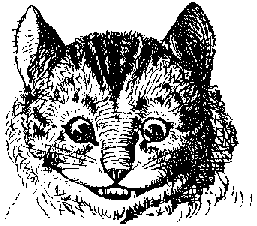U-Alice Ezweni Lezimanga
Alice’s Adventures in Wonderland in Zulu

By Lewis Carroll, translated into Zulu by Bhekinkosi Ntuli
First edition, 2014. Illustrations by John Tenniel. Cathair na Mart: Evertype. ISBN 978-1-78201-065-4 (paperback), price: €12.95, £10.95, $15.95.Click on the book cover on the right to order this book from Amazon.co.uk!
Or if you are in North America, order the book from Amazon.com!
| “In that direction,” the Cat said, waving its right paw around, “lives a Hatter: and in that direction,” waving the other paw, “lives a March Hare. Visit either you like: they’re both mad.” | “Ngaleya,” kusho iKati, likhomba ngesidladla sangakwesokudla, “kuhlala iginiphigi uSozigqoko; ngalaphaya,” likhomba ngesinye isidladla, “kuhlala uNogwaja kaMashi. Ungahambela noma ngumuphi omthandayo, iqiniso nje ukuthi bayahlanya bobabili.” | |
| “But I don’t want to go among mad people,” Alice remarked. | “Kepha mina angifuni ukuhlala nabantu abahlanyayo,” kuphawula u-Alice. | |
| “Oh, you ca’n’t help that,” said the Cat: “we’re all mad here. I’m mad. You’re mad.” | “Habe, awukwazi ukukuguqula lokho; kunjalo nje,” kusho iKati, “sonke lapha siyazihlanyela. Ngiyahlanya, nawe uyahlanya, yinto enjalo nje.” | |
| “How do you know I’m mad?” said Alice. | “Wazi kanjani ukuthi ngiyahlanya mina?” kubuza u-Alice. | |
| “You must be,” said the Cat, “or you wouldn't have come here.” | “Kufanele ukuthi uyahlanya,” kusho iKati, “phela ubungasoze weza lapha kwabahlanyayo ungahlanyi.” | |

|
||
| Indaba ethi Alice’s Adventures in Wonderland ngumphumela wogqozi lukaMfundisi Charles Lutwidge Dodgson owazalwa ngoMasingana ngonyaka we-1832 eDaresbury, eCheshire. Izincwadi zobucikomazwi wazikhipha ngegama lakhe losiba likaLewis Carroll. Wedlula emhlabeni ngo-1898. | The story Alice’s Adventures in Wonderland was written by the Rev. Charles Lutwidge Dodgson, who was born in January in 1832 at Daresbury in Cheshire. His literary works appeared under the penname of Lewis Carroll. He passed away in 1898. | |
| Incwadi yakhe esidume ngelika-Alice in Wonderland yashicilelwa okokuqala ngo-1865. Ukungena kwale ndaba enkundleni yezincwadi kwavusa isasasa elikhulu kubafundi bezincwadi, kangangoba nabakhuluma ezinye izilimi bafisa ukuba ihunyushelwe ezilimi zabo. Emva kweminyaka eyishumi nanye nje ishicilelwe ngesiNgisi, yase itholakala nangezinye izilimi, njengesiJalimane, isiFulentshi, isiSwidi, isiNtaliyane, isiDashi, nesiRashiya. Eminyakeni yawo-1900, kwavela imvula yezihumusho. Nangayo le minyaka yawo-2000 isahushunywa. Nokho sazi ukuthi okokuqala ukuba kushicilelwe isihumusho sesiZulu. | His book, which is popularly referred to as Alice in Wonderland, was published for the first time in 1865. Its appearance triggered much interest among readers, and people of other languages were keen to have it translated into their languages. Within a few years of its first publication it was available in languages such as German, French, Swedish, Italian, Dutch, and Russian. In the 1900s a flood of other translations appeared. Even in the current century new translations are being published. As far as we know, this is the first translation to be published in isiZulu. | |
| Incwadi okulokhu kuqhubeke njalo ukuhunyushwa kwayo noma seyedlula iminyaka eyikhulu yashicilelwa okokuqala, kusho ukuthi inokuthile okuyenza ibe ngenye yezincwadi okuthiwa ngezingasoze zabuna. Ukuthi lokhu kubangwa yini, umfundi uyozitholela uma eseyifunda indaba. Noma ibonakala sengathi yayibhalelwa izingane, inokuthile okudonsa nabadala ukuba bayithokozele. Bonke abahumushi bababaza izinselelo okubaphonsele zona ukuyihumusha. Ngizobala ezimbalwa nje abhekane nazo umhumushi wesiZulu. | It is evident that the book is a true classic since even today its appeal has not diminished. The readers will discover for themselves what it is that makes the book so special. Superficially, it may seem to be an ordinary children’s book while, in fact, it offers adults as well much to enjoy and think about. All the translators find the task of rendering the book in other languages challenging in many ways. I will mention only a few challenges that the isiZulu translator had to face and how he tried to deal with them. | |
| Okusobala ukuthi indaba inesimo senhlalo sale koNgilandi. Uma konke bekungahunyushwa njengoba kubhaliwe, bekuzogqama kakhulu ukuthi lena yincwadi yelinye izwe. Umhumushi uzame ukukuletha nganeno okunye. Okunye okube ngumbuzo ukuthi amagama abalingiswa uwabhala njengoba etholakala encwadini yesiNgisi yini noma uwabhala ngesiZulu, noma uyawahumusha, noma uqamba amasha. Kusebenze konke lokhu kulesi sihumusho. Amagama anjengo-Alice no-Ann awaguqulwanga ngoba vele baningi o-Alice abangamaZulu amagama abo angaguqulwa neze kuthiwe: Alisi, Eni, njalonjalo. Kodwa esahlukweni 7, esikhundleni sika-Lacie no-Tillie, kufakwe amagama esiZulu, uThandiwe noBuhle, ukuze indaba ibe nomoya “wasekhaya”. Amagama abanye abalingiswa abanjengo-Two, no-Five, ahunyushwe kwathiwa: Mbili, Nhlanu. | The story has an English setting. An attempt to get an exact equivalent of every English word or expression would accentuate the foreignness of the story to an isiZulu reader. In some places the translator tried to bring the story “nearer home”. With regard to the names of the characters, for example, he had to decide which ones could be kept in English and which ones could be translated or changed to new ones. Names such as Alice and Ann were retained partly because they have been used as names for Zulu women for a very long time. It was felt there was no need to give them the isiZulu spelling such as u-Alisi and u-Eni. Less commonly used names, Lacie and Tillie were substituted with well known names: Thandiwe ‘Loved One’ and Buhle ‘Beauty’. Numerical names such as Two and Five were simply translated to Mbili ‘Two’ and Hlanu ‘Five’. | |
| Ithemba elikhulu ngelokuthi abayifundayo le ncwadi bayowathokozela amaphupho ka-Alice Ezweni Lezimanga. | It is sincerely hoped that the readers of isiZulu will enjoy following Alice’s dream in the world of wonders. | |